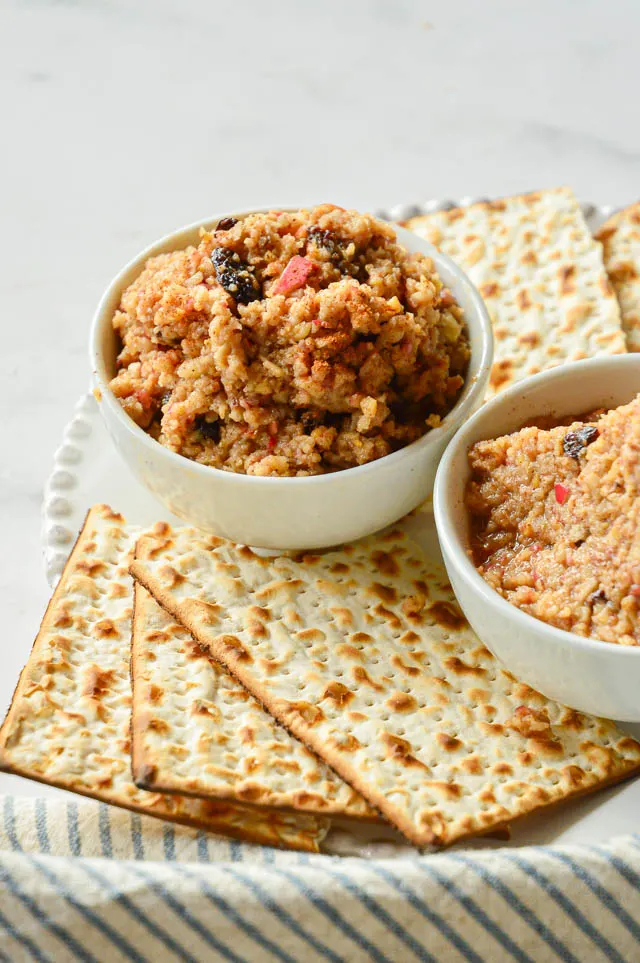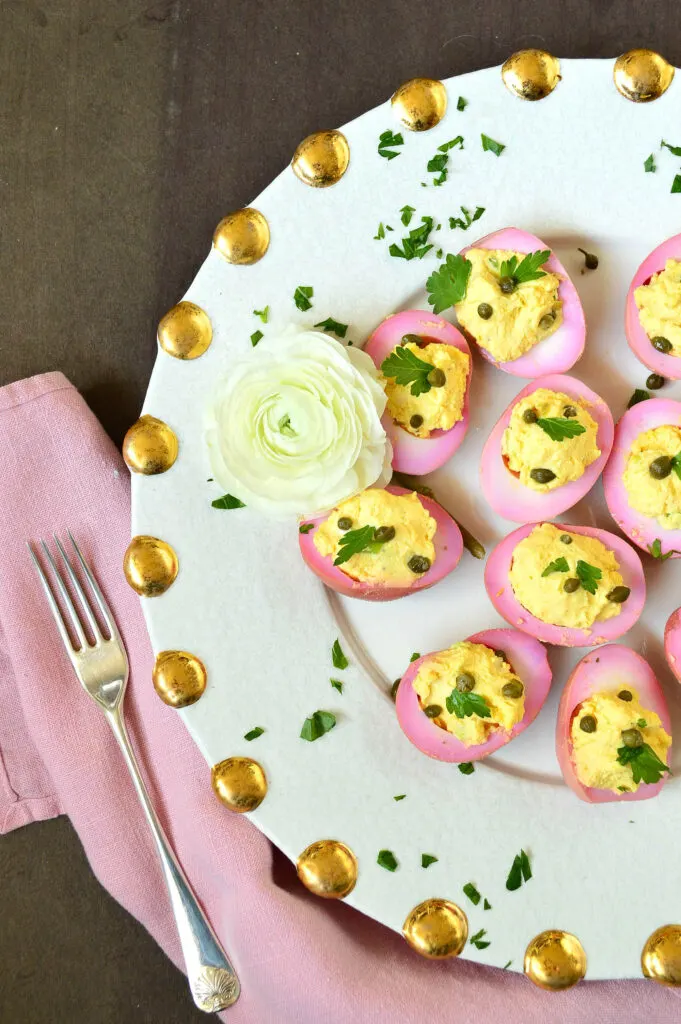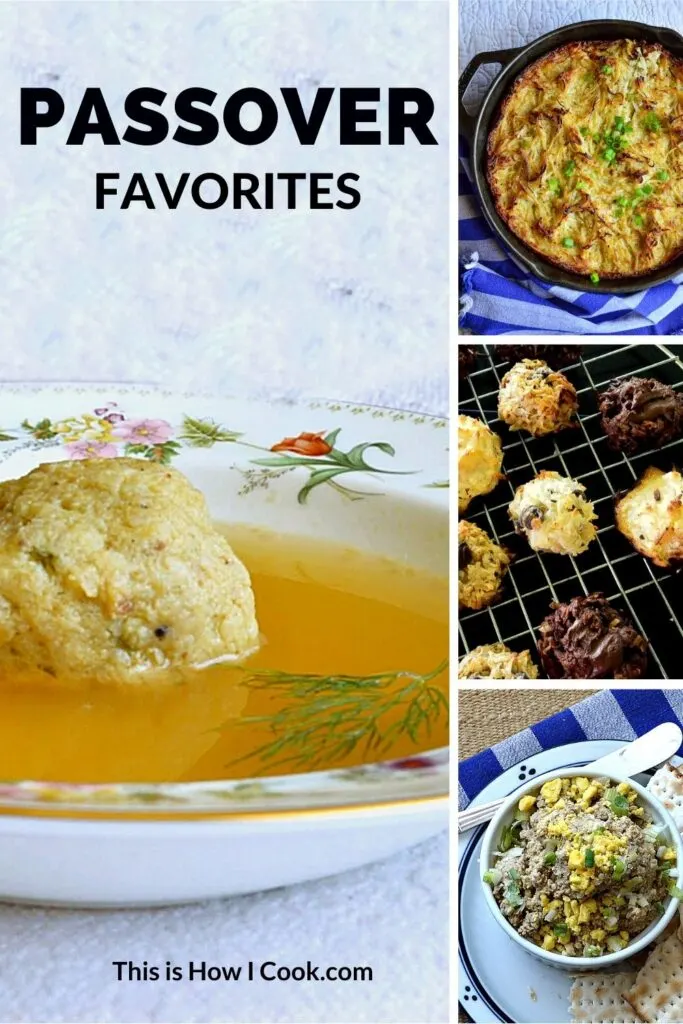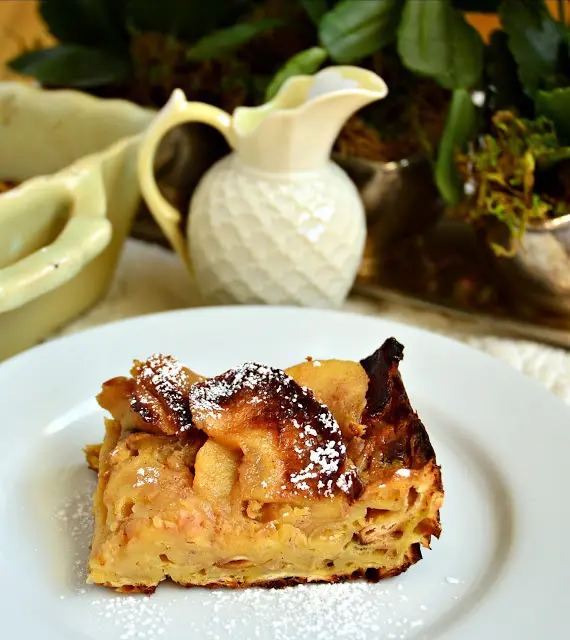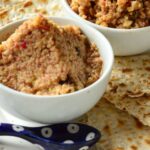Charoset, made in the Ashkenazi style, is made with apples, raisins and nuts. This easy Passover charoset recipe with grape juice instead of wine, sweetens this already sweet concoction. One of my favorite foods at our Passover Seder, charoset is something everyone should try!
This post may contain affiliate links of which I may or may not be paid a small commission at no cost to you.

As one of the oldest and most cherished dishes on the Passover table, charoset symbolizes the mortar used by Israelite slaves in ancient Egypt.
This sweet spread is a fundamental part of the Passover Seder, sitting proudly alongside bitter herbs, matzo, and other symbolic foods on the Seder plate that graces every Passover table.
There are countless variations of this dish across different cultures and regions, but one thing remains constant:everyone loves their version of charoset!
I often make two kinds of charoset-this traditional Eastern European version and I usually make a Sephardic version too.
The Separdic Jews lived in the Iberian Peninsula, meaning they were from Spain and Portugal primarily.
There are also Mizrahi Jews from North Africa and the Middle East.
So you see, that makes for a lot of different charoset recipes using many different ingredients, because things like apples were probably not so common in Spain!
After research for this year’s Seder I think I will be making a charoset recipe from Suriname, a Dutch colony in South America!

Table of Contents
Why this Passover Charoset Recipe with Grape Juice is So Good:
Not only is charoset so easy to make, it is so good.
I look forward to this easy charoset recipe every year, often wondering why I only make it once a year!
Who doesn’t like apples and cinnamon and nuts?
This sweet recipe offsets the bitterness of the horseradish on the Seder plate and is an integral part of the Seder meal.
And because the Seder celebrates our redemption from being slaves in Egypt, some of us even form our charoset into pyramids!

Ingredients for Passover Charoset Recipe With Grape Juice
Apples: Sweet apples such as Pink Lady, Gala, or Honeycrisp, as well as a tart variety like Granny Smith(I prefer a balance of sweet and tart. Think tart apples like Granny Smith, but I’ve used them in combination with red Delicious, too. This year I used SugarBees. My new favorite variety!)
Nuts (Traditionally I use walnuts-toasted or not. You could use pecans and Sephardic versions often contain pistachios or almonds.)
Sugar or Brown Sugar. Some even use honey. (sometimes the apples are balanced off with a little extra sweetness.)
Grape Juice or wine – I love having a container of grape juice at home and since I don’t have sweet wine around, I use grape juice. However they can be used interchangeably, though check for sweetness. Port or sherry can also be used.
Ground Cinnamon
Regular or Golden Raisins – Not often seen in Ashkenazic charoset, I like them so I use them, but you can certainly leave them out. They will plump up after sitting with the apples so this is a great way to use old raisins!
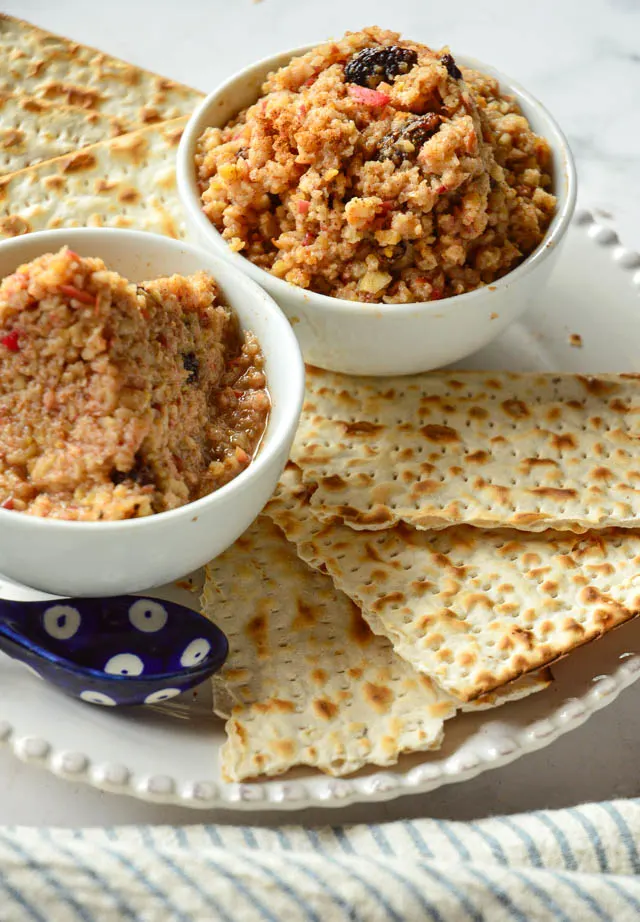
How To Make Passover Charoset Recipe with Grape Juice
Well, I hope you have a food processor. Imagine the Bubbie’s chopping this!
With your food processor this is beyond easy!
Just cut the apples into quarters and cut those into halves and take everything except the raisins and juice and throw it into the food processor.
Pulse it on and off until the desired consistency is reached.
I have seen charoset chopped rough and I have seen it more like the clay or mortar it is intended to be.
Personally, I like mine!
Remove apple mixture to a large bowl and add concord grape juice to blend this together. Stir in the raisins and check for sweetness.
Once fully combined, transfer the charoset to an airtight container and refrigerate for at least an hour or several days to allow the flavors to meld together and the raisins to plump up.
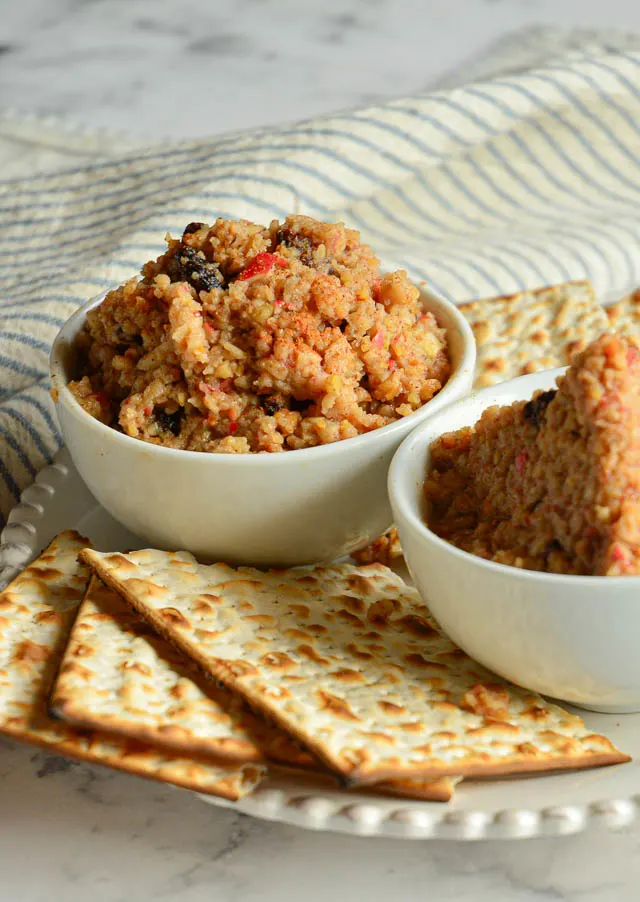
What does Charoset Mean?
Charoset is enjoyed during the Passover dinner, and is seen on every Seder plate around the world.
Its roots trace back to the Hebrew word “cheres,” meaning clay or earth, emphasizing its connection to the Israelite slaves’ labor in ancient Egypt.
Charoset also represents the optimism of the Seder, reminding us of the sweetness that emerges from adversity.
Why a charoset recipe without wine?
Though wine is traditional to add to charoset, some do not drink alcohol and on Passover drinking 4 cups of kosher wine is essential to having a Seder.
Though it is pretty easy to find kosher wine (think Manischewitz wine) even now I imagine in some places, it still isn’t easy to find.
In that case substitute kosher grape juice!
Apparently-and after all these years I just learned this-according to the Palestinian Talmud charoset is made with wine: because wine is referred to in Genesis as the “blood of grapes.”
Tips For Making Charoset
- Experiment with different types of nuts and dried fruits to create your own unique blend of flavors.
- If you prefer a chunkier texture, pulse the ingredients in the food processor fewer times or hand-chop them with a knife.
- Some traditional charoset recipes incorporate pomegranate juice or blackberry wine for an added depth of flavor.
- Remember that charoset tastes even better the next day, so don’t hesitate to make it in advance.
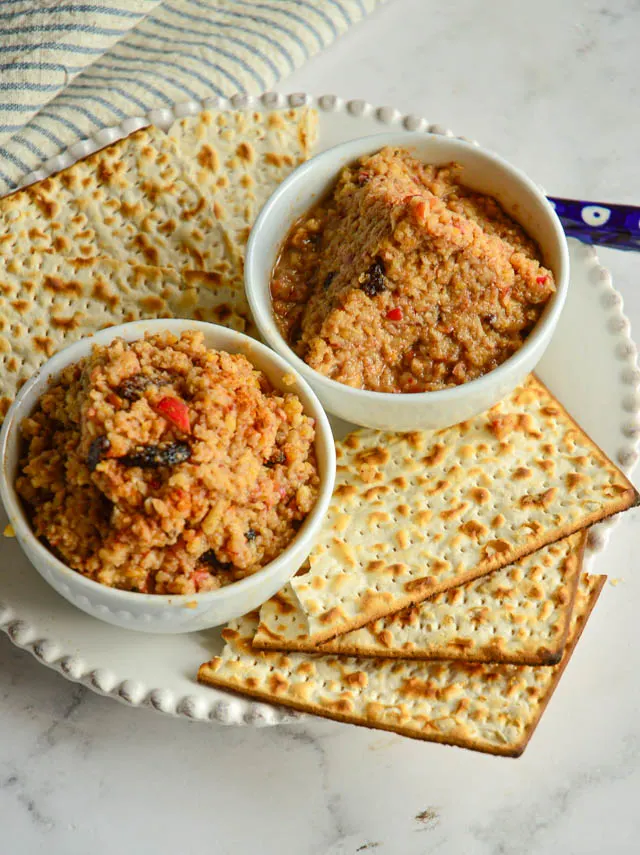
How To Serve Charoset:
Charoset is genearally placed in a large serving bowl and passed around the table as part of the Passover tradition during the Seder.
Serve it as a spread on top of matzo or alongside matzo ball soup for a sweet side.
It also pairs beautifully with gefilte fish or as part of the Hillel sandwich, symbolizing the bitterness of the horseradish and the sweetness of the charoset.
I also love serving charoset on a cheese platter. It goes great on a cracker with Cheddar!
It also works, when drained, as a filling for grilled cheese! Yum!
Leftovers can also be used in cake or mixed into matzo brei.
As one of the most iconic symbols of the Jewish Passover holiday, charoset holds a special place on the Seder table and in the hearts of Jewish people around the world.
Whether enjoyed as part of a traditional meal or incorporated into contemporary dishes, its sweetness serves as a reminder of hope and resilience, echoing the enduring spirit of the Jewish community.
And now, more than ever, we could all use some hope.
However I would say resilience is in our nature, as we have learned to survive for over 5000 years.
Here’s a prayer for the hostages that we will be saying this year:
Our family, the whole house of Israel, who are in distress, or in captivity — who stand either in the sea or on dry land — may the Omnipresent have mercy on them and take them out from narrowness to expanse, and from darkness to light, and from oppression to redemption, now, swiftly, and soon!
So this Passover, embrace our traditions, savor the flavors of food and life, and share the sweetness of this Passover charoset recipe with grape juice with loved ones, and take a bite for those who cannot partake.
Happy Passover!
Other Passover Recipes to Enjoy!
Instead of a hard boiled egg, try pickled eggs!
All of my Favorite Passover Recipes in One Spot
Print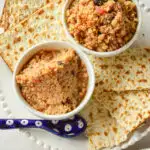
How To Make Charoset
- Prep Time: 15 Minutes
- Total Time: 15 minutes
- Yield: 6 – 8 Servings 1x
- Category: Side dish
- Cuisine: Jewish
Description
Charoset, made in the Ashkenazi style, is made with apples, raisins and nuts. This easy Passover charoset recipe with grape juice instead of wine, sweetens this already sweet concoction. One of my favorite foods at our Passover Seder, charoset is something everyone should try!
Ingredients
3/4 c toasted walnuts
2 – 3 T sugar, brown sugar or combination of both
2 – 3 Apples, peeled and Cored (I used SugarBee)
1 t ground cinnamon
1/2 c raisins
2 – 4 T grape juice or sweet wine
Instructions
Toast walnuts for extra flavor. Let cool.
Slice apples into 4 large wedges.
Place everything but raisins, and grape juice or wine into food processor.
Using the on/off motion pulse the food processor until the consistency you like is achieved. Some like bigger chunks but I pulse this until I think it resembles mortar.
Scrape into bowl and add grape juice as needed to sweeten. You can also add extra cinnamon which also naturally sweetens the mixture. Taste for sweetness and then stir in raisins.
Store in an airtight container. If you used juicy apples you may need to drain the juce before serving.
Notes
I mkae this a few days ahead. It will turn brown but still taste great. Feel free to use the apple of your choice. I’ve often used a combination of Granny Smith and another sweet variety. Sugar added is dependent on your taste.
Raisins are optional also.

